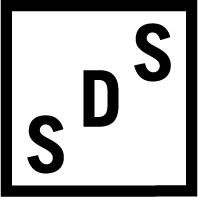Industrial Studio Glass
For a long time, we have been interested in techniques for making glass that are not entirely freehand, but still take advantage of all the strengths that handmade glass has to offer.
Making glass by hand has advantages and disadvantages. It can be more expensive, more time consuming, more difficult, and less predictable. On the other hand, the process is also exciting, lively, supports experimentation, diversity between each pieces, and less obvious techniques that can't be programmed into a traditional factory lineup like using burning wood to texture the surface of a glass piece.
Our friend and glass historian Megan Greer helped us find some historical examples of production glassware techniques that balance control within a collection while still leaving room for unexpected results. Surprisingly, most of the examples of glassblowing that lie in between mass produced and studio art glass are Scandinavian instead of Italian!
Gunnel Nyman, Vase (1940s). Image courtesy of nordlingsantik.se
One of the most surprising approaches we learned about was controlling bubbles and using them as a design element rather than looking at them as a mistake or inconsistency. Gunnel Nyman uses a variation on the Swedish Kraka technique (even though she is Finnish) to trap a grid of bubbles in between layers of glass.
Image courtesy of nordlingsantik.se
Because the bubbles are embedded inside the glass before the shape of vessel is blown, the movement of the material causes subtle warping in the pattern. I think a little evidence of human hands is good here. If the pattern were too perfect, it might feel too cold and impersonal.
Gunnel Nyman, Viel (1942). Image courtesy of bukowskis.com
Another example of a Nyman vase with a net of bubbles. The bubbles and color really highlight the different layers glass that are gathered to build up the material needed to make the piece. 1 layer of clear beneath the amber, the amber glass, a mesh of interlocking clear glass who's negative spaces will trap bubbles between them, and 1 gather on top of that which traps the bubbles, and maybe one more to add thickness. Most likely 4-5 layers in total.
Ingeborg Lundin for Orrefors, Ariel Vase (1962). Image courtesy of Pamono.com
Ingeborg Lundin also uses trapped air bubbles as part of her design. Because the bubbles are bigger here, you can see that not all of them are perfectly round which makes sense. I think the differences between bubbles and even the subtle differences between pieces using same design are part of the charm. The bubbles will deform based on the glass's movements and heat differences. The glassblower would have control of the overall shape, but not over those shifts within the volume of the material which I think is good. The bubbles will naturally act like bubbles, not how we imagine bubbles should be.
Image courtesy of Iittala
Another Finnish designer, Tapio Wirkkala (who we've taked about before), uses the natural texture of burned wood to give each cup within a collection individuality. As the wooden mold burns, the texture changes to give each new vessel gradual variations over time.
Tapio Wirkkala, Ultima Thule Sparkling wine glass (1968). Image courtesy of Iittala
Image by Super Duper Studio
Tapio Wirkkala, Ultima Thule Set (1968). Image courtesy of Iittala
The texture of the vessels makes them very warm and approachable. I feel that I want to pick them up to touch the wooden texture translated into the glass.
Aalvar Alto, Savoy Vase Mold. Image courtesy of Iittala
Aalvar Alto (another Finn) also designed his famous Savoy vase using a burned out wooden mold to give the glass it's wavy shape.
Aalvar Alto, Savoy Vase (1936). Image courtesy of Iittala
Even though the design that's in production today uses a cork-lined iron mold because it lasts longer than wood, the original prototypes were made by blowing the glass into an arrangment of sticks in the ground.
The glass blew outwards in between the sticks giving each bulge the natural curve of the material instead of forcing an unnatural curve on the glass. Of course, today the Savoy vase isn't made by blowing into sticks in the ground, but the unique prototyping technique and the ability to move the sticks around to try new shapes quickly, lead to a form that would be difficult to refine without being able to respond to the flow of the material.
Christopher Yamane is an industrial designer and Co-Founder of Super Duper Studio
Special thanks to glass historian Megan Greer who helped us research these pieces and finally told us the name of the Industrial Studio Glass movement.












